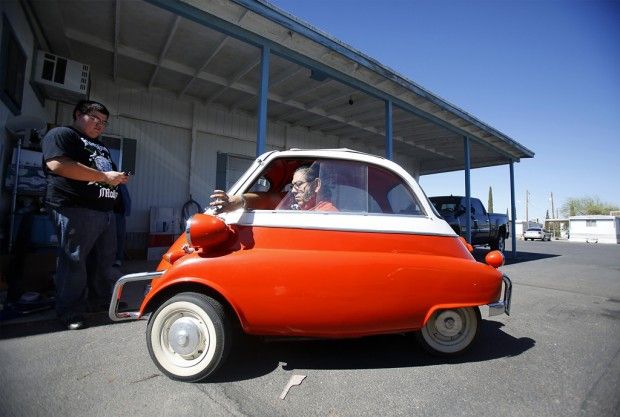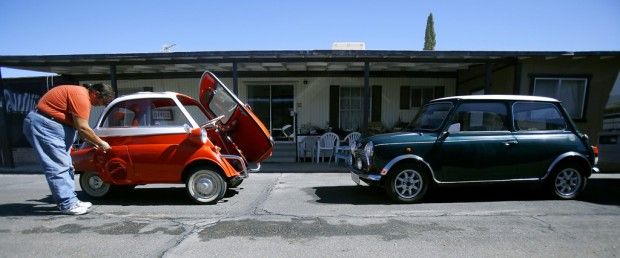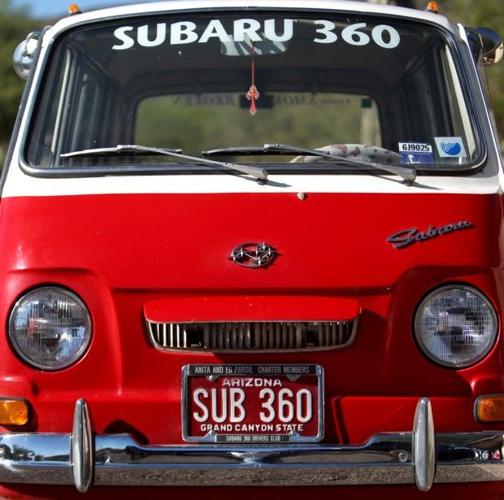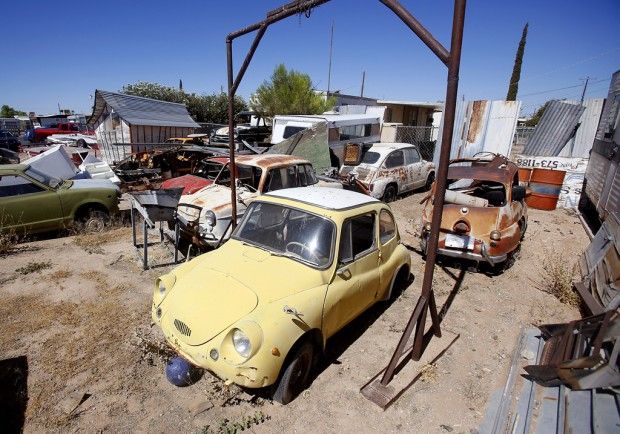We've grown accustomed to seeing Volkswagen's New Beetle, BMW's Mini and, most recently, the modern version of the Fiat 500.
But in Tucson, the cars to which these retro micro cars pay tribute are still around - maybe more than anyplace in the country, thanks to our bone-dry, anti-oxide climate and devoted small-car aficionados.
Most of those modern retro mini cars have their roots in post-World War II recovery, cars for the common people of Europe and Japan - countries that hadn't already been marketed to by a Henry Ford. Among them: the German VW Beetle, Italian Fiat 500s, British Mini Coopers, Japanese Subaru 360s and Honda 600s, and the French Citroën 2CVs.
Many of them caught on in the United States in the 1960s and '70s and were often as much a sign of the times as peace signs and tie-dyed shirts. They certainly weren't your father's Buicks, or Chevys or Fords.
To the people who really love these little cars - now known as city cars or micro cars - it's often more than a matter of saving money on gas.
• • •
Ed Parsil says it was efficiency - the horror of 45 cents-a-gallon gasoline in the early 1970s - that first caused him to consider and then buy a tiny Subaru 360 micro car.
"I thought I would be practical and my wife thought it would be cute," Parsil says.
Since then, the 360s have become more of a hobby than a practical thing. His wife's hulking Toyota Prius gets better gas mileage, has air conditioning and bunch of other attributes that the old Subarus can't match.
A Subaru 360, either the tiny sedan he bought in the 1970s or the shoulder-high van version he owns, is so small you could probably fit it into the back of a full-size modern pickup.
They're powered by a tiny (360cc displacement) two-cylinder, two-cycle, air-cooled engine. When all is well, the motor pumps out 25 horsepower. That's not much, even for a motorcycle. It was also rated at 66 miles per gallon, a bit optimistic says Parsil, who clarifies: "real world is about 45 miles per gallon."
The Subaru 360 has an overall length of 117.9 inches (about 9 3/4 feet), bumper to bumper. That's shorter than the wheelbase - axle to axle - dimensions of some modern cars. The sedan version weighs a mere 925 pounds depending on whether the 6.6 gallon gas tank is full.
Parsil says the Subarus deserve some love because they were thoughtfully designed and well engineered, not just curiosity pieces. Parsil says he put more than 125,000 miles on one of the used Subaru 360s he bought, driving it for 21 years before selling it for $5,000 in the 1990s ($1,297 was the manufacturer's suggested retail price back in the day).
Parsil's little red-and-white 360 van starts immediately and gets plenty of exercise, mostly zipping around Tucson Estates, and occasionally making a run into Tucson proper.
Parsil was a founder of a nationwide club for 360 owners, the Subaru 360 Drivers Club, and an annual micro-car show that hops among Tucson, Phoenix, Las Vegas and Southern California.
• • •
The first of the modern tributes to the original little cars was the New Beetle by Volkswagen released in 1997. Since then, we've had the retro Mini by BMW in 2001 and the new version of the Fiat 500 in 2011. The miniature Smart car, designed by Swatch and made by the owners of Mercedes-Benz, isn't really a retro car, but made a big splash in Europe and the U.S., when it was introduced here in 2008. Some people were paying huge premiums for gray-market Smarts before then.
Even the retro versions of the 1960s and '70s micro cars have virtually nothing in common with the originals, save their names and a few styling cues. VW further diluted the original bug's DNA by restyling the latest version, flattening out the iconic humped shape, morphing it into something that also hints of a modern Porsche Boxster. (And that's not without significance, because Porsche's creator first designed the original Volkswagen sedan.)
The New Beetle is a front-engine, water-cooled, front-wheel drive car; the original was a rear-engine, air-cooled rear-wheel-drive car. The modern Mini is huge compared to the original British car. Believe it or not, so is the new Fiat. Side-by-side with the originals, the new versions look massive. Modern safety and air pollution requirements, at least in most countries, wouldn't allow strictly holding true to the original designs.
British car fan Bob Schlanger points out that there is a significant connection between the old and new micro cars, particularly the Mini.
"It was the first mass-produced econo-car with front-wheel drive, what everything is today," Schlanger says of the original British Mini. He says the Mini's creator, Sir Alec Issigonis, was a genius in designing the highly efficient Mini. Back then, most cars were pushed by their rear wheels, an arrangement that required a drive shaft from the front engine to transfer power to the rear axle, adding weight and intruding on the interior space of the car. There had been other front-wheel-drive cars, but Schlanger says the Mini was the first mass-produced success. It changed England, putting the working class on the road, almost as dramatically as Henry Ford did with his Model T decades earlier in the U.S.
The Mini front-wheel-drive design's weight savings were important, off-setting the increased weight of today's car design added by modern amenities such as air conditioning and automatic transmissions, and required safety and pollution equipment. Part of the weight savings came from space efficiency, with 80 percent of the little hatchback car's floorpan devoted to passengers and cargo, thanks to the engine and drivetrain taking up only a small area at its front.
• • •
Schlanger owns British Car Service, 2854 N. Stone Ave., a decades-old fixture in the local British car scene. And while powerful Jaguars and other virile Brit sports cars old and new come there for service, Schlanger admits an affection for the often under-powered vintage micro cars. The affection extends to an Italian micro. There's a faded red '60s Fiat 500 out in the lot that's more likely to see action than some of the more exotic stuff from which he could choose.
Even though Schlanger specializes in British cars, and his personal pile of retirement project cars is almost strictly of English descent (MGs, Triumphs, even a TVR), he's opened his service garage's doors to BMW's modern version of the Mini. (Until this year, there was no Mini dealer in Tucson and owners had to go to Phoenix, or send their cars there by truck, for authorized service at a Mini dealership.)
Fittingly, Schlanger's also servicing Mazda Miatas, perhaps the first, true modern retro small car - one with a British soul. The body of the original Miata, a minimalist two-seat sports car introduced in 1989, is a reverent take on the Lotus Elan, a beloved British-made sports car of the 1960s and '70s.
His business, which includes a small, old-fashioned showroom that occasionally features a restored car for sale, is filled inside and out with cars that would give car nuts a grin. There are quirky Morgans, tiny Morris Minors, Jaguars of all ages, sporty MGs and Triumphs, British cabs, and original Minis - including one with a faded Union Jack on the roof. Schlanger says he also has two other locations where he stores parts cars and cars waiting for restoration.
They're small, he'll take a couple dozen.
• • •
Barney Rael is active in the state and local chapters of the Dynamic Mini Collective club. The group is mainly made up of owners of modern retro Minis, but there are also original Minis represented on some of the club's outings.
How did he get this deeply into really small cars? "I've got a wife (Debbie) who enjoys and encourages it," says Rael. "She drives a 2012 Mini Cooper. She has the family four-door, the Countryman S." Their sons drive modern Minis, too. "All of ours, the 2003 and 2004, are S models (supercharged or turbocharged). They're about as fun of an economical car as one can own. Just a ton of fun."
But his real interest is in old micro cars. Rael has old Minis and a couple dozen other micro cars from the 1950s, '60s and '70s in various stages of repair: The collection includes several NSU Prinz models, particularly handsome, almost dignified little German-made sedans and sports models that were popular throughout Europe, but were discontinued after Volkswagen bought NSU and supposedly saw them as competing with VW's own small cars.
Rael has a 1957 BMW Isetta, a strange car among strange cars. An unusually tiny, rear-engined car, the whole front of the car is the door. Rather than getting in through the side, it is more like sitting on a public toilet and closing the stall door.
"We probably have 14 licensed (cars) and 21 insured. I'd have to do the calculations," says Rael of his micro-motor pool. That, of course, doesn't include the future projects and parts cars.
• • •
Many friends are made through small cars.
Rael knows many, if not most, of the micro car fans in Southern Arizona. It's not just a Tucson thing. Most every small town, and some spots in between, have one or two micro car lovers.
Not surprisingly, there's a fairly eccentric and eclectic collection of micros in Bisbee. Regular visitors have probably seen one or more of the old Citroën 2CVs putting down Tombstone Canyon. One, a panel truck version of the French automaker's take on the Volkswagen.
Asked if he knows about the guy with 2CVs in Bisbee, Rael says "Sure" and rattles off a name without even stopping to think about it.
"It's a small world when it comes to small cars," says Rael.
• • •
Let's not forget the bugs and the Beetles.
In the midst of all these obscure micro cars, real Volkswagen bugs seem almost commonplace. The most successful of all the post-World War II micro cars has a loyal following in Tucson. Again thanks to the dry desert air, many of the 1950s, '60s and '70s VW bugs that survived the butcherous 1970s dune buggy craze are still on the road. The VW Microbus (aka Kombi or Transporter) vans are particularly popular, some going for a small fortune, depending on the year and condition.
The DHP (Dry Heat Panzers) VW Club, a loosely organized bunch of fans of old VWs, trade cars and parts back and forth and help each other with repairs.
At a recent meet up in the parking lot of the Lucky Wishbone, 990 S. Harrison Road, there was only one traditional bug. David Fenion's 1960 bug is primer gray, lacks a rear bumper and is definitely not a purist's car, but he says that's in keeping with the club's loose feel: "no meetings, et cetera, about 60 members, a website."
The loose organization works well enough for some people that there are chapters in New Mexico and Las Vegas.
Fenion's car came with a 1200cc motor, but he'd upgraded to a later, more powerful, 1600cc engine. It also has a more powerful alternator, needed to power the car's big stereo, Fenion says. He's not reverent about keeping things stock, obviously, but that doesn't mean he doesn't respect the cars.
Fenion's a certified VW mechanic, and until recently worked for a dealer. He has a more modern VW, too - a 1991 Jetta. He says the old cars were, and are, great cars. Parts are readily available. Between authorized VW and aftermarket parts, you can almost build a Beetle from the parts bin.
"Ever since I could remember, I started drawing pictures (of cars) as a little kid, when I was eight- or nine years old. I had older brothers that were into them," Fenion says.
The real head turner among the group here this evening is John Clevenger's VW Karmann Ghia Type III, a rare version of the familiar low-slung sports model VW Karmann Ghia. He says the Type III was never sold in this country, although some were imported directly. Rare or not, Clevenger isn't driving a VW museum exhibit. The car is immaculate, but he says the nonstock candy red metallic paint job is heresy to some VW enthusiasts. Besides the paint job, it has an upgraded 2100cc motor with twin Weber carburetors.
"I just like 'em. I know how to work on them," Clevenger says of his VW affection.
"Why spend $18,000 (on a new Beetle) when you can get one of these? Purists? Yeah. There's a guy up in Phoenix that's like that with these (Type IIIs). He won't even talk to me," Clevenger says, laughing and obviously relishing the furor over his car's flashy paint job. Better yet, he says the car took second place in the Type II class at the recent Bug-O-Rama VW show in Phoenix.
DHP member José Merino has a faded, rusty in some places, 1960s-era VW microbus, lowered and without a shiny part to be seen. He's got a big reflective sticker across the back that says, "Slow Moving Vehicle." There's nothing flashy about this, except maybe the turn signals. He likes it that way, at least for now.
Merino, the former editor of the Star's Spanish-language newspaper, La Estrella, isn't keen on Volkswagen's modern retro Beetles. "I think they missed the mark by not making it rear-wheel drive," he says of the new versions. "It's a girl's car. You get more reaction from people in one of these."
More online
• 360 owners, the Subaru 360 Drivers Club: subaru360club.org
• Dynamic Mini Collective club: dynamicminicollective.org
Dan Sorenson's first car was a 1961 Volkswagen Beetle with a sunroof. It was almost an MGA, but his father saved him from that. On a wet Saturday during his junior year in high school, armed with a few hundred dollars saved from his convenience store job, the two were prowling Washington, D.C., import-car lots. But, in the pouring rain, none of the British sports cars he was lusting after would start. But the shiny black 1961 VW did. Sorenson's current vices are old Volvos and BMW motorcycles.








